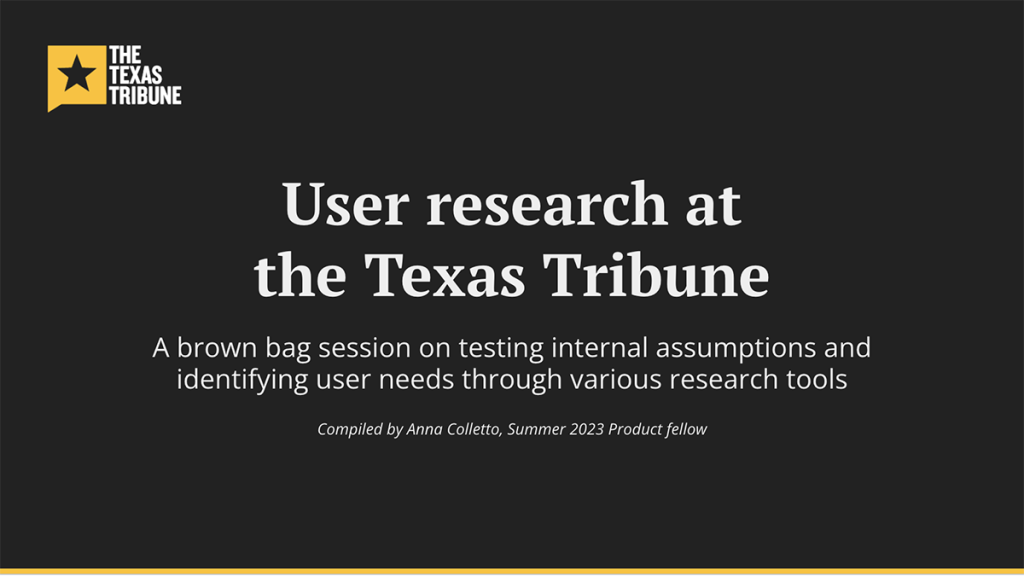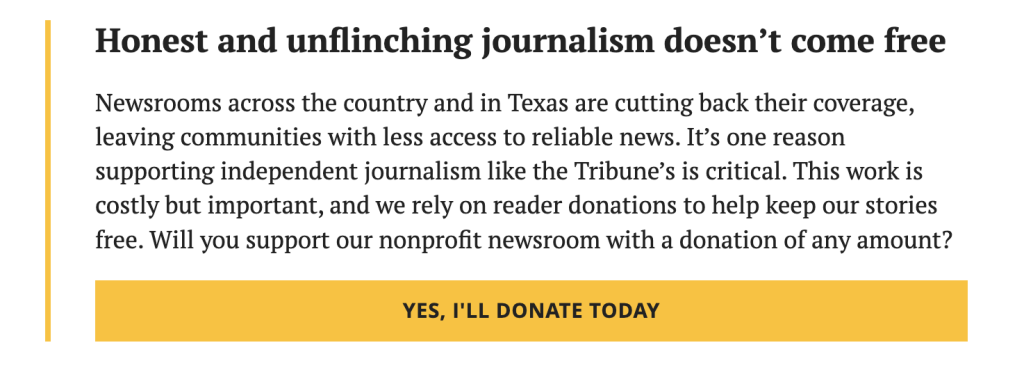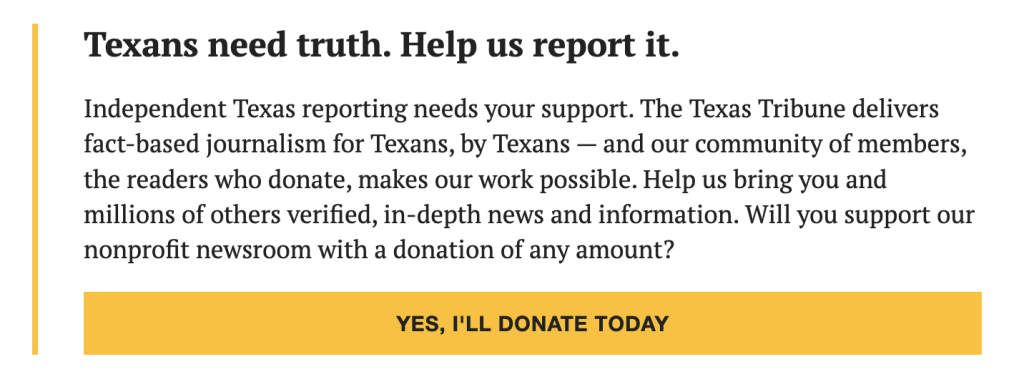
Fellow Anna Colletto presented a brown bag session about user research at the Texas Tribune.
Build a culture and practice of user research across the newsroom
Translate your team’s projects into a culture of listening to users, data-informed products and frequent research sprint
Anna Colletto is a 2023 RJI Student Innovation Fellow partnered with the product team at The Texas Tribune in Austin. The RJI Student Fellows will be sharing their work this summer through Innovation in Focus.
Gathering user research can be powerful for your newsroom, but it is most effective when these insights are not isolated within one team but shared and translated across the organization.
After a summer of several user research projects and sprints at The Texas Tribune, we sought to break down the walls around our insights and share them across the newsroom. We led a brown bag with two primary goals: presenting our work and setting the newsroom up for future research initiatives. Here’s how to conduct user research, no matter where you’re at in your newsroom:
Address your assumptions
We found our research was most effective and useful when it began with our assumptions about user needs and behaviors as a jumping off point, or hypothesis to test. Especially if your newsroom, like ours, has conducted research sprints in the past, you might be operating under outdated or inaccurate information about your audience. By laying out your theories prior to beginning your project, you and your team are then able to correct or reaffirm them with tailored and specific data points.
In our extended research on the Texas Tribune’s membership program, we entered the project with the assumption that “Membership” is a tangible idea that members connect with. However, our research demonstrated that members in fact connect with our reporting and journalistic products more strongly than any membership benefit or identity. This insight then translated into action, causing us to rethink appeals, outreach and even the program’s structure.
Go beyond a survey
Several tools and strategies helped throughout the user research process, including:
Internal information gathering
Identify what you already know, collecting all recent research, documentation and analysis of your target audience or product. This allows you to build research based on what you already have (or what you’re currently lacking). Here, look at what did and didn’t work before. Did the survey translate into action and impact? Or is it just a Google Doc buried in a folder? This is also a great stage to set up communication across teams on goals, needs and potential roadblocks, ensuring the project is useful and sustainable for all relevant actors in the organization.
User interviews and (yes) surveys are a great way to balance qualitative and quantitative data on your audience. By setting up multiple overlapping sprints of both, these tools can work off and inform one another, deepening the nuance of your insights. Representation is key here. While useful, it is important to remember that interviews and surveys are not complete sources of truth — you will never be able to speak with every member of your audience. Incorporating analysis of the respondent groups and demographics into your takeaways is essential to presenting the information as accurately as possible.
Experimentation can begin at any stage in the process. Applying your insights while conducting research can serve as a litmus test for your findings and guide your next steps. These do not have to be high tech: experimentation can be as simple as changing copy or the structure of your content. All experiments require is a variable to test and a method of tracking results.
While in the middle of our membership research project, we tested a copy change to the footer of our articles — evaluating a new appeal based on our findings. In this test, we crafted two appeals, one focused on Texas Tribune need and one based on the value of our product. Overwhelmingly, the latter generated more donation interest, a finding that aligned with our quantitative and qualitative data from other research areas.


Iterating with the whole toolkit
Not every area of the newsroom needs a multipronged, months-long research sprint. Some might do well with a five-question survey. User interviews, surveys and product experiments are all valuable tools, but some might work better at testing your core questions than others. Chart the goals for your project first, then decide what combination of tactics your team needs to meet them.
As the research progresses, move between your tools — constantly using them to inform each other. User research isn’t a straight line from surveys, to interviews, to results. Surprising responses to a survey question may spur a content experiment designed to evaluate its validity, while your survey is in the field. Use your whole toolkit throughout your projects, it will only make your insights stronger.
Deciding where to start
Begin with what your team, or your organization, wants to know. You’re journalists — ask the hard questions! We set up a Figma space to allow members of our newsroom to brainstorm on where they’d like to see user research go next. Using the Figma jam feature, we documented the brainstorm with digital Post-its, ensuring that the topics discussed could be easily communicated outside of our session. Their ideas spanned across new products, outdated projects, content focus, and new staff positions. From there, we dove into our assumptions, an activity that generated more research ideas.
As brainstorming is happening and more research initiatives spring up across the newsroom, establishing a consistent research process for all future projects and product areas is a useful step. By building this culture and practice of user research, the entire newsroom — and not just the one team focused on user research — can be prepared to collaborate on solutions for better reaching your audiences.
